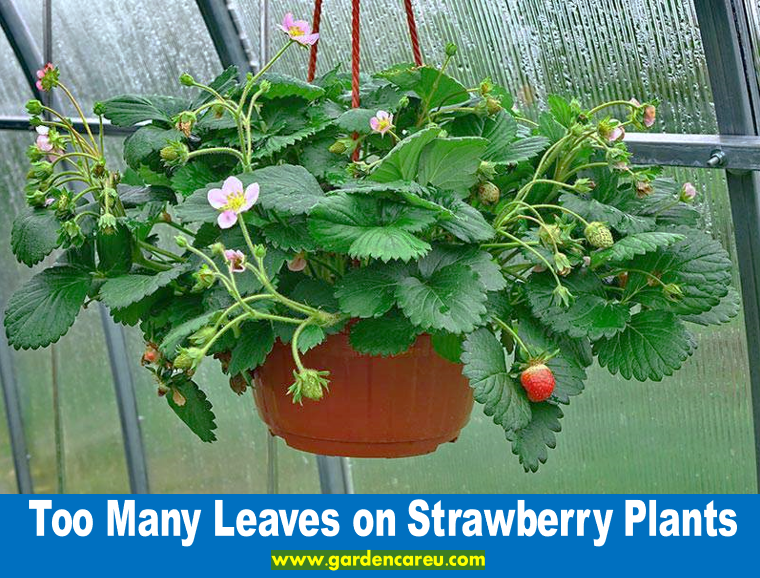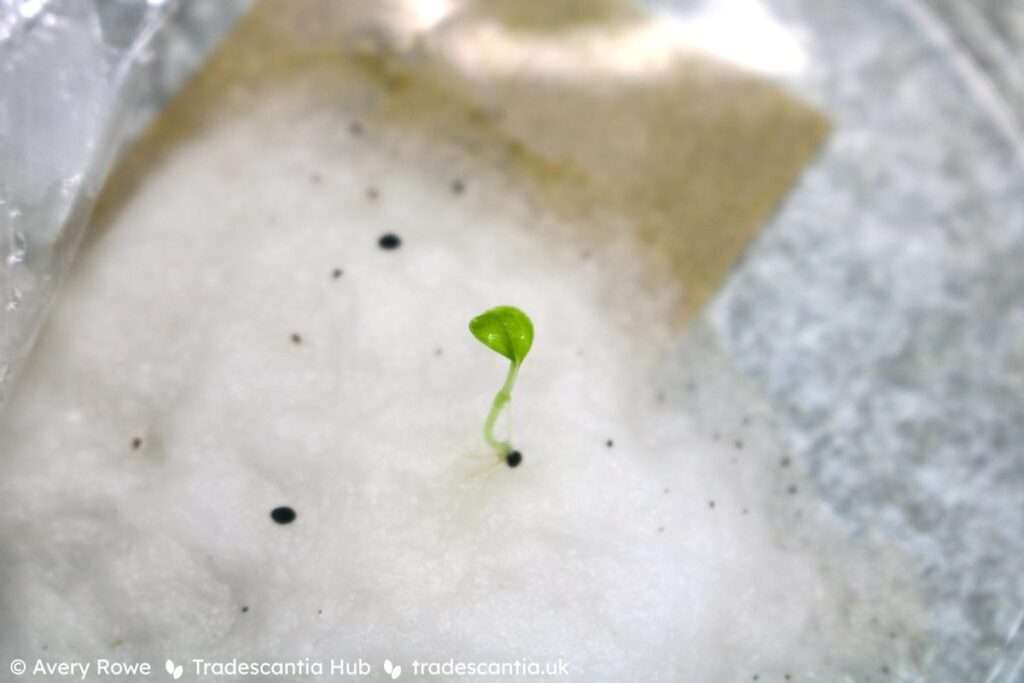Too Many Leaves on Strawberry Plants: If your strawberry plants have too many leaves, they may not produce as many fruits. Remove excess leaves to promote fruit growth.
Strawberry plants with abundant leaves can hinder fruit production due to the plant’s energy allocation. Proper leaf management is crucial for maximizing fruit yield. We will discuss the reasons behind excessive leaves on strawberry plants and provide tips on effectively addressing this issue.
By understanding the impact of leaf quantity on fruit development, you can ensure a bountiful harvest from your strawberry plants. Let’s delve into the strategies for managing excessive foliage on your strawberry plants to optimize their growth potential and enhance fruit production.
[ez-toc]

Understanding Strawberry Plant Leaves
Too many leaves on your strawberry plants can hinder their growth and fruit production. To address this, you can prune the runners and remove old leaves to allow the plant to focus its energy on producing strawberries instead of excessive foliage.
Understanding Strawberry Plant Leaves Strawberry plant leaves play a crucial role in the health and productivity of the plant. They are responsible for photosynthesis, which produces sugars and energy needed for fruit development. The leaves also serve as a protective layer, shielding the plant from excessive sunlight and potential damage. Understanding the signs of too many leaves and their impact on plant health is essential for optimizing the growth and productivity of strawberry plants.
Signs Of Too Many Leaves
When a strawberry plant has too many leaves, there are several visible signs to watch out for. These include overcrowding of leaves, which can lead to poor air circulation and increase the risk of diseases. Additionally, an excessive number of leaves can result in a lack of sunlight penetration to the lower parts of the plant, hampering fruit development. Identifying these signs is crucial for addressing the issue effectively and maintaining the plant’s overall health.
Impact On Plant Health
The overabundance of leaves can negatively impact the health of the strawberry plant. Too many leaves can restrict the plant’s ability to allocate resources effectively, reducing fruit production. Furthermore, excessive foliage can create a favorable environment for pests and diseases, threatening the plant’s overall well-being. By understanding the impact of an overabundance of leaves on plant health, appropriate measures can be taken to ensure optimal growth and productivity. By recognizing the signs of too many leaves and understanding their impact on plant health, strawberry plant enthusiasts can take proactive steps to maintain the ideal leaf-to-fruit balance, resulting in healthier and more productive plants.
Pruning Techniques For Strawberry Leaves
Managing the abundance of leaves on strawberry plants is crucial for promoting healthy growth and maximizing fruit production. Proper pruning techniques can help maintain the plant’s vitality and encourage better yields. When pruning strawberry leaves, following the correct timing and method is essential.
When To Prune
Pruning should be done in the early spring or late fall when the plant is dormant to avoid stressing it during active growth.
Correct Pruning Method
Correct pruning involves removing old, damaged, or overcrowded leaves to improve air circulation and sunlight penetration, which are crucial for fruit development.
Tools For Pruning
- Sharp pruning shears to make clean cuts without damaging the plant
- Gloves to protect your hands from thorns and debris
- Disinfectant to sterilize your tools between cuts and prevent the spread of diseases
Managing Runners On Strawberry Plants
Runners are long stems that form on strawberry plants and can quickly overcrowd your garden if not properly managed. These runners, also known as stolons, are responsible for producing new plants, essential for the continuous growth and propagation of strawberry plants. However, allowing too many runners to develop can lead to excessive leaf growth, diverting valuable energy away from fruit production.
Reasons For Managing Runners
There are several reasons why it is crucial to manage runners on strawberry plants:
- Energy Conservation: Runners divert much of the plant’s energy that could otherwise be utilized for fruit production. Cutting off excessive runners allows the plant to concentrate on growing larger and sweeter strawberries.
- Prevention of Overcrowding: If left unchecked, runners spread rapidly and can overcrowd your strawberry patch. This overcrowding can lead to a lack of airflow, increased disease susceptibility, and reduced berry production.
- Improved Aesthetic Appeal: Removing runners helps maintain a neat and organized garden bed, making it easier to access the plants for cultivation, harvesting, and overall maintenance.
Best Practices For Runner Removal
Proper runner removal is crucial to ensure the health and productivity of your strawberry plants. Here are some best practices:
- Identify and Select Runners: First, identify the runners that are overcrowding your plants. Look for long stems with miniature plantlets emerging from them.
- Choose the Optimal Time: It is best to remove runners during the growing season when the plants produce new shoots before they become too established.
- Use Clean and Sharp Tools: Ensure your tools are clean and sharp before removing the runners. This will minimize the risk of introducing diseases to the plants.
- Cut and Remove Runners: Cut the runners as close to the main plant using sterilized pruning shears or scissors. Remove the cuttings and any excess foliage to maintain a clean, uncluttered garden bed.
- Consider Propagation: To propagate new strawberry plants, select a few healthy and well-developed runners and transplant them into new pots or garden beds. This will allow you to expand your strawberry patch while controlling runner growth.
By following these best practices, you can effectively manage runners on your strawberry plants and promote healthier, more productive plants. Balancing runner removal and fruit production is key to a successful strawberry harvest.
Strategies For Improving Strawberry Plant Yield
To improve strawberry plant yield and manage excessive foliage, consider strategies like pruning runners, removing flowers, fertilizing, and mulching. Proper maintenance, such as cutting back old leaves and providing adequate nutrients and water, can help optimize fruit production.
Optimizing Fertilization
Proper fertilization is crucial for maximizing strawberry plant yield. Utilize a balanced fertilizer with equal parts nitrogen, phosphorus, and potassium.
- Apply fertilizer when planting and every 4-6 weeks throughout the growing season for optimal results.
- Monitor the nutrient levels in the soil to adjust fertilization accordingly.
Ensuring Adequate Watering
Adequate watering is essential for the health and productivity of strawberry plants. Maintain consistent moisture levels to prevent stress.
- Water deeply but infrequently to encourage deep root growth.
- Avoid over-watering as it can lead to root rot and nutrient leaching.
Reusing Strawberry Leaves For Better Plant Health
Reusing strawberry leaves can provide numerous benefits for your plants’ overall health and productivity. When the leaves have fulfilled their primary photosynthetic function, they can contribute to the plant’s well-being in several ways.
Proper methods must be followed to ensure the effective reappearance of the leaves. Several reapplication techniques can be employed to harness the full potential of reusing strawberry leaves for better plant health.
Common Strawberry Plant Leaf Problems
To prevent too many leaves on strawberry plants, carefully prune excess foliage to promote better air circulation and sunlight penetration, reducing the risk of diseases. Keep a balanced leaf-to-fruit ratio for optimal plant health and strawberry production. Regularly inspect and trim overcrowded leaves to support vigorous growth and higher yields.
Identifying Leaf Issues
When growing strawberries, it is crucial to keep a close eye on the leaves. Identifying leaf issues early on can prevent serious problems down the line. Common leaf issues include discoloration, yellowing, browning, spotting, and unusual growth patterns.
Nutrient deficiencies, over-watering, pests, diseases, or environmental stressors can cause these issues. By inspecting the leaves regularly, you can promptly address any problems and ensure the overall health of your strawberry plants.
Preventive Measures
To maintain healthy leaf growth and prevent common issues, consider implementing the following preventive measures:
- Ensure proper soil drainage to prevent waterlogging, which can lead to root rot and leaf discoloration.
- Monitor nutrient levels and provide appropriate fertilization to address deficiencies that may impact leaf health.
- Control pests and diseases through regular inspection and prompt treatment using organic or chemical methods as necessary.
- Protect plants from extreme weather conditions, such as excessive heat or cold, which can stress the leaves and impact plant health.

Frequently Asked Questions Of Too Many Leaves On Strawberry Plants
Should I Cut the Leaves Off Strawberry Plants?
Cutting leaves off strawberry plants helps the plant focus energy on producing fruit. Removing old leaves also promotes growth.
How Many Leaves Should A Strawberry Plant Have?
Strawberry plants typically have three leaflets on each leaf petiole, but they can have more.
What Does An Overwatered Strawberry Plant Look Like?
An overwatered strawberry plant may have brown or yellow leaves and stunted growth. Cutting off old leaves can help the plant thrive without wasting energy.
Should I Cut Runners Off Strawberry Plants?
Cutting runners off strawberry plants redirects plant energy for larger fruit yield. Remove emerging runners in the first two years, letting some remain in year three for propagation.
Why Are There So Many Leaves On My Strawberry Plants?
Strawberry plants have multiple leaves to maximize photosynthesis and support fruit production.
Is It Normal For Strawberry Plants To Have More Than Three Leaves?
It is not unusual for strawberry plants to have more than three leaves on each leaf petiole.
Conclusion
Too many leaves on your strawberry plants can hinder fruit production and overall health. Proper pruning and maintenance techniques are key. Remember, a balanced plant is a productive plant. By following these tips, you can ensure your strawberries thrive and yield a bountiful harvest.


